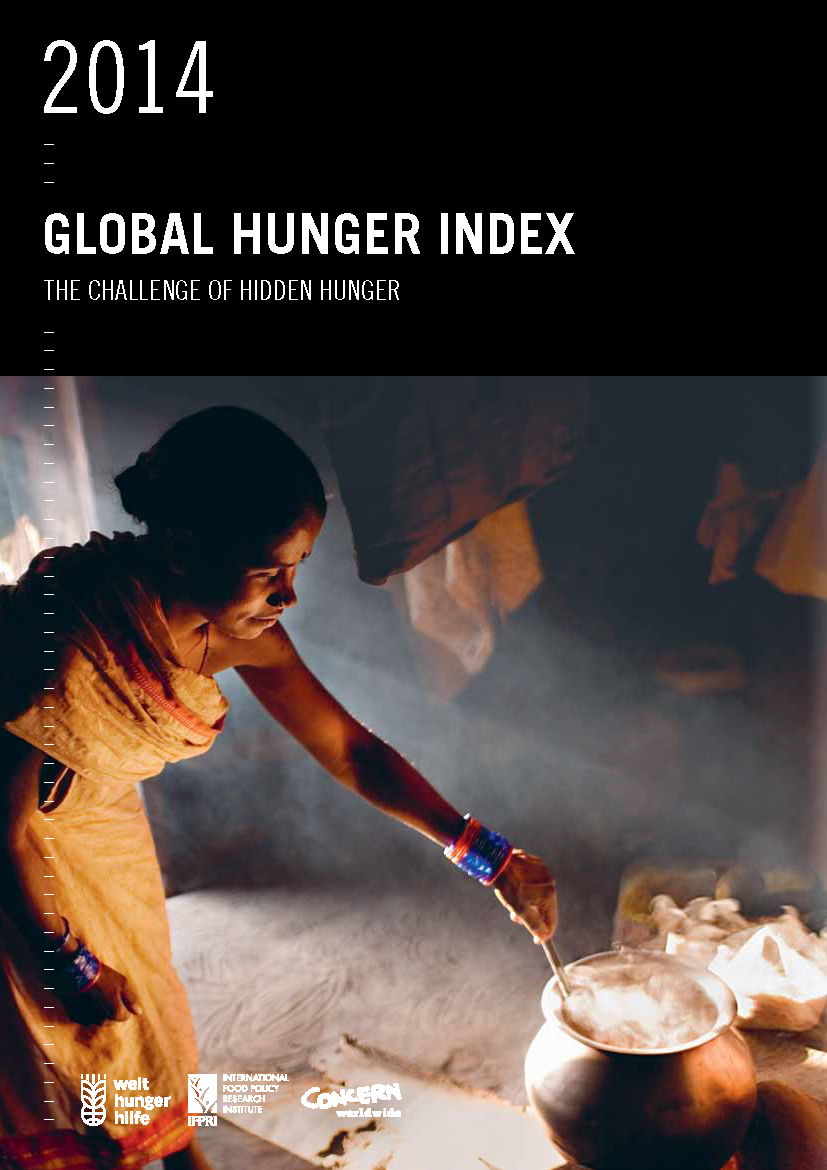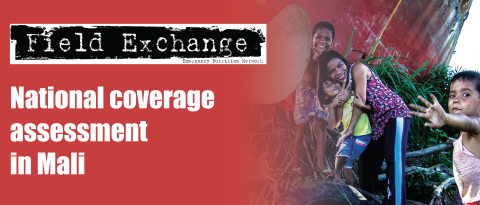Global Hunger Index Report
 The 2014 Global Hunger Index (GHI) report - the ninth in an annual series - presents a multidimensional measure of national, regional, and global hunger in the shape of the Global Hunger Index (GHI). The GHI is produced in a collaborative effort between the International Food Policy Research Institute (IFPRI), Concern Worldwide and Welthungerhilfe. This GHI is a composite measure of hunger that combines three (equally weighted) measures:
The 2014 Global Hunger Index (GHI) report - the ninth in an annual series - presents a multidimensional measure of national, regional, and global hunger in the shape of the Global Hunger Index (GHI). The GHI is produced in a collaborative effort between the International Food Policy Research Institute (IFPRI), Concern Worldwide and Welthungerhilfe. This GHI is a composite measure of hunger that combines three (equally weighted) measures:
- Undernourishment (food supply based)
- Underweight of under 5's (capturing food, care and health), and
- Under 5 mortality rates (capturing the interplay of diet and infection).
The tool is designed to comprehensively measure, analyse, track and record the state of hunger worldwide, highlighting the countries and regions where action is most needed. It is intended to mark country level progress, incentivise and guide action, and strengthen accountability. Global, regional and national trends can be observed and analysed.
According to the 2014 GHI, the state of hunger in developing countries as a group has fallen by 39% since 1990; overall absolute scores have declined from 20.6 in 1990, to 12.5 in 2014. Over the same period, 26 countries reduced their scores by 50% or more. In terms of absolute progress, comparing the 1990 GHI and the 2014 GHI, Angola, Bangladesh, Cambodia, Chad, Ghana, Malawi, Niger, Rwanda, Thailand, and Vietnam saw the biggest improvements in scores.
 However, the level of world hunger is still “serious”, affecting 805 million people. The global average obscures dramatic differences across regions and countries. Regionally, the highest GHI scores (highest hunger levels) are in Africa south of the Sahara and in South Asia, which have also experienced the greatest absolute improvements since 2005. South Asia saw the steepest absolute decline in GHI scores since 1990; progress in addressing child underweight was the main factor behind this. Levels of hunger are “extremely alarming” or “alarming” in 16 countries, with Burundi and Eritrea both classified as “extremely alarming.” Reliable data for the Democratic Republic of the Congo and Somalia, however, are lacking.
However, the level of world hunger is still “serious”, affecting 805 million people. The global average obscures dramatic differences across regions and countries. Regionally, the highest GHI scores (highest hunger levels) are in Africa south of the Sahara and in South Asia, which have also experienced the greatest absolute improvements since 2005. South Asia saw the steepest absolute decline in GHI scores since 1990; progress in addressing child underweight was the main factor behind this. Levels of hunger are “extremely alarming” or “alarming” in 16 countries, with Burundi and Eritrea both classified as “extremely alarming.” Reliable data for the Democratic Republic of the Congo and Somalia, however, are lacking.
This year’s report focuses on ‘hidden hunger’ – also called micronutrient deficiency - that is often overlooked and affects more than an estimated 2 billion people globally. The repercussions of these vitamin and mineral deficiencies are both serious and long-lasting. The GHI shows that progress on some micronutrient deficiencies is worryingly slow. While some success has been made, particularly for Vitamin A supplementation for children under-5 and universal salt iodisation, anaemia reduction is falling far short of the targets (only five out of 185 countries are on course to meet the World Health Assembly (WHA) targets for women of reproductive age1). Some of the reasons for the slow progress on anaemia might include:
- Lack of awareness of the magnitude of the problem due to difficulties of accurate measurement and poor understanding that anaemia results not only from poor quality food, but also is a result of parasitic and infectious diseases.
- Lack of awareness of our current slow progress and poor understanding of the economic consequences (e.g. lethargy and fatigue render the workforce less productive).
- It affects women more than men.
- Lack of appropriate platforms to deliver interventions at scale to key target groups.
A number of recommendations are made in the 2014 report as steps to eliminate hidden hunger. In addition to demonstrable political commitment by Government, there is a need to build capacity in nutrition through investment and development of human and financial resources by Governments and multilateral institutions, increased coordination, and transparent monitoring and evaluation. Governments must also create a regulatory environment that values good nutrition, e.g. creating incentives for private sector companies to develop more nutritious seeds or foods. Transparent accountability systems are needed in order to ensure that investments contribute to public health, while standardised data collection on micronutrient deficiencies can build the evidence base on the efficacy and cost effectiveness of food-based solutions.
The GHI 2014 Report and related resources (including interactive maps, data, media content and video) is available at: http://www.ifpri.org/publication/2014-global-hunger-index?
1Source: Global Nutrition Report, http://globalnutritionreport.org/


